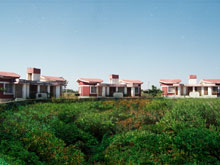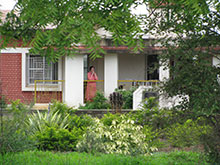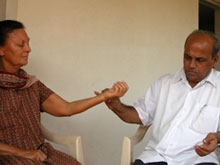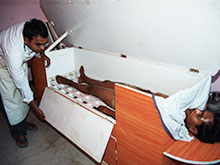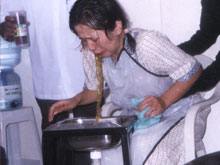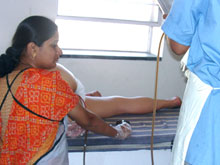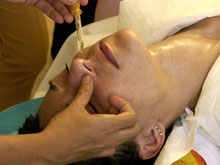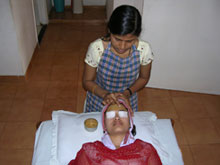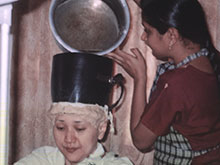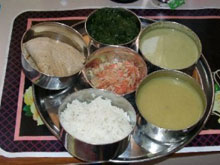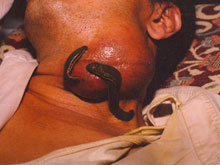According to Ayurved, human body is composed of the three doshas, the seven dhatus & three malas. Equilibrium of the dosha, dhatu & mala maintains the healthy state of body & mind. But imbalance in any of them gives rise to disease. The purpose of Ayurved is to maintain this equilibrium. This can be achieved by two methods. One is to pacify the dosha or by eliminate the dosha by nearby route i.e. Panchakarma. Panchakarma acts as a curative as well as preventive therapy. It is purifying as well as rejuvenating procedure.
SHAMANA :-
The treatment, which doesn’t eliminate the doshas or elevate those, which are in normal condition but tries to bring equilibrium in the imbalanced doshas, is called as “Shamana”.
It can be done in seven ways:
1. Pachana 2. Deepana [Appetizers] 3. Kshudha [Fasting] 4. Trushna 5. Vyayama [Exercise] 6. Aatapa [Sun bath] 7. Maruta
SHODHANA (PANCHAKARMA TREATMENT) :-
The treatment through which increased doshas are eliminated and balance is established between them is referred to as “Shodhana” i.e. Panchakarma.
Panchakarma comprises of three parts i.e. Poorvakarma (Preparator Process), Pradhankarma (Main treatment) and Pashchatkarma (Regimen to be followed afterwards.
Poorvakarma (Preparatory Procedures) :-
Before performing these processes “POORVAKARMA” (Preparatory processes) have been mentioned they are :Snehana (oleation) and Swedana (sudation). By performing these processes the doshas which are spread in the body get accumulated in the koshtha (trunk) and can be easily removed. Pitta and Vata doshas are eliminated through the anus while Kapha dosha is eliminated through the mouth. If the doshas are situated in the stomach (Aamashaya) they are eliminated through the mouth and if situated in the intestine (Pakvashaya) through anus.
A person in whom kapha and pitta doshas have increased, who is obese, has the strength to withstand the processes who is suffering from indigestion, diarrhoea, constipation etc. is eligible for shodhana treatment.
Snehana (Oleation Therapy)
To give steam bath to the body or the affected part may be described as swedana. It is mainly performed after snehana since snehana softens the doshas and swedana liquiefies them, directing them towards the kostha [trunk] for elimination. Swedana is recommended in the following diseases:
- Headache
- Facial Paralysis
- Hemiplegia
- Rigidity or spasmodic pain in the flanks, back, waist etc.
- Sciatica , Pain in the muscles of thigh, calf muscles
- Oedema
- Gaurava [feeling of heaviness in the body]
Swedana is contra indicated in diseases like diabetes, diarrhoea, anaemia, ascites, in indigestion. It is also contraindicated in pregnancy.
While performing sudation care should be taken to protect the heart, eyes and testes. It should be performed till the person feels light and the pain subsides. BENEFITS OF SWEDANA –
By performing sudation the body becomes soft, the doshas get loosened from the affected srotasas [system] and get directed towards the koshtha
Swedana (Sudation)
To give steam bath to the body or the affected part may be described as swedana. It is mainly performed after snehana since snehana softens the doshas and swedana liquiefies them, directing them towards the kostha [trunk] for elimination. Swedana is recommended in the following diseases:
- Headache
- Facial Paralysis
- Hemiplegia
- Rigidity or spasmodic pain in the flanks, back, waist etc.
- Sciatica , Pain in the muscles of thigh, calf muscles
- Oedema
- Gaurava [feeling of heaviness in the body]
Swedana is contra indicated in diseases like diabetes, diarrhoea, anaemia, ascites, in indigestion. It is also contraindicated in pregnancy.
While performing sudation care should be taken to protect the heart, eyes and testes. It should be performed till the person feels light and the pain subsides.
BENEFITS OF SWEDANA –
By performing sudation the body becomes soft, the doshas get loosened from the affected srotasas [system] and get directed towards the koshtha
Pradhan Karma (Main Treatment) :-
Pradhankarma is a part of panchakarma therapy which is considered a very vital treatment in ayurveda.
Panchakarma internally purifies the body through the use of medicines. Its meaning implies five therapeutic treatments.
Pradhankarma cleanses the body by removing toxins from it. It is one of the significant elements of panchakarma therapy.
Swedana (Sudation)
In this process the infected doshas are thrown out of the body by medication of emetics. It is the most effective treatment in Kapha dosha. Vaman is recommended in Vasant rutu [spring season] since there is natural increase of kapha dosha in our body. In a disease having predominance of kapha dosha, Vaman can be performed at any time after performing snehana and swedana. Indications –
- Kushtha (Leprosy or Skin diseases)
- Navjwara (Fever)
- Diarrhoea
- Shilpada (Elephantasis)
- Granthi (Lump)
- Kasa (Cough)
- Shwasa (Asthama)
- Hrillasa (Nausea)
- Pratishaya (Cold)
- Visha (Poisons/toxins in the body) etc.
It has been contra indicated in obese person, in acute abdominal conditions, in anaemia, in helmenthic infections, sorethroat, in epistaxis or in a person who has taken enema.
While describing these processes specific age limits have been mentioned-
Vamana should not be performed before ten years of age or after seventy years.
Virechana (Purgation)
The process by which increased doshas situated in the intestines [pakvashaya] are eliminated through the anus is called as Virechana. It is the main treatment on increased Pitta dosha and is recommended in Sharad rutu due to its natural increase in the specified season. Though this may be the case it can be performed in any season depending on the severity of the disease. Indications –
- Arsha (Piles)
- Visphota (Boils)
- Kamala (Jaundice)
- Udara (Ascites)
- Udarashula (Pain in abdomen)
- Yoni dosha (Gynaecological disorders)
- Krumi (Helmenthesis)
- Vatarakta (Gout)
- Malavarodha (Constipation) etc.
It has been contra indicated in fever, lack of appetite or in weak, feeble individuals. While describing these processes specific age limits have been mentioned-
Virechana should not be performed before ten years of age or after seventy years.
Shirovirechna / Nasya (Nasal administration of Medicated drops)
Nose is said to be the entrance to the head [Brain] .
Shirovirechana eliminates the increased doshas situated in the head.This is a process in which the medication is given through the nose. The medication is either in powdered form which is blown in the nostrils through certain specific instruments or in the form of medicated oils which is given with the help of dropper.
Indications –
- For maintaining health
- Headache
- Hicca (Hiccups)
- Manyastambha (Cervical spondylosis)
- Swarabhransha (Sore throat)
- Epilepsy
- Skin disorders etc.
Benefits –
By performing Nasya the breathing process becomes smooth and the indriyas [Special senses] i.e the nose, ears, eyes, throat, tongue strengthen and improve their function.
Basti (Enema)
Since most of the diseases are caused due to imbalance in Vata dosha this treatment is said to cure half of the diseases.It has been referred as “Ardha Chikitsa”. Though this treatment can be used according to the gravity of the disease it is mainly to be performed in the varsha rutu [Rainy season] owing to the natural increase of Vata dosha in this season.
It is of three types –
- Nirooha Basti –
It mainly contains decoction of medicinal herbs and a little amount of fat in it. It has been indicated in gout, diabetes, hyperacidity, disuria, meterrorhagia, heart diseases.So also it is not recommended in weak person or one who is suffering from abdominal distention, piles, diarhoea, dysentry, vomitting, cough, asthama. - Auvasana Basti –
Indications –
- Anaha (Distended abdomen)
- Vatarakta (Gout)
- Pleeha (Splenomegaly)
- Aatisaara (Diarrhoea)
- Pratishaya (Cold)
- Malavrodha (Constipation)
- Ashmari
- Rajonaasha (Amenorrhea)
- Vata-rogas (various diseases caused due to imbalance of vata dosha)etc.
It has been contra indicated in Anaemia, Jaundice, Pyrexia (Fever), Piles, Common cold, Splenomegaly, Helmenthic infections.
Raktamokshana (Blood letting)
Rakta or blood has been described as the fourth dosha by some acharyas. It is called “Jeevan” or life.If there is any disturbance in its circulation, constitution it causes disease. So to reduce the rakta dushti or impurites of the blood this process has been described. “Rakta mokshana” means extracting blood from the body through certain specific equipments like Shrunga [horn of an animal], Alabu [An instrument prepared from dried bottlegourd], Jalauka [Leech] , Siravedha [puncturing a vein]. Indications –
- Vidradhi (Pus formation)
- Pleeha (Increased spleen)
- Agnimandya (Loss of appetite)
- Jwara (Fever)
- Netra, Mukha, Shiroroga (Diseases pertaining to eyes, mouth, head)
- Trushana (Excessive thirst)
- Kushtha (Leprosy/Skin diseases)
- Vatarakta (Gout)
- Bharma (Vertigo)
- Liver disorders.
– These diseases are caused due to impurities in rakta dosha. It has been contra indicated in piles , anaemia, pregnancy, asthama, diarrhoea, one who has undergone oleation, sudation or any other panchkarma treatment.
While describing these processes specific age limits have been mentioned-
Vaman and Virechana should not be performed before ten years of age or after seventy years.
Shirovirechana should not be performed before seven years and after eighty years.
Sirovedhana should not be done before sixteen years or after seventy years.
OtherAllied Procedures
Shirodhara
The patient is asked to lie down over taila droni. Tail/ Ghee/ Butter milk/ etc. should be showered over the head of the patient. The showering height should be at least 4 to 5 inches. During this procedure, massage on head is necessary. Showering should be done for about 20 to 25 minutes. After completion of the procedure Head should be cleaned with hot water and warm cloth. Absolute mental and physical rest is necessary.
Shirobasti
After completing oleation and sudation therapy at evening patient is advised to sit on a chair. A leather strip is wound around patient’s head just above the eyebrows. It is tightened using string. The edges (the junction of head and the leather bag) of the leather bag should be sealed with dough made from black gram flour. Lukewarm medicated oil is poured into it till it reaches the level 2 inches in height above head, which will oleate the crown. This should be kept till the nose starts running, eyes become watery. After completion of this procedure gentle massage is done on the neck and shoulders.
Katibasti
The patient is advised to sleep in prone position (i.e. on his abdomen). A ring 2 inches in height is formed using wet black gram flour is fitted on the back (on the affected vertebras). The edges (the junction between the bag and back) of the bag should be sealed neatly. Medicated oil (lukewarm) is poured into the bag up to 2 inches in height, which will oleate that encircled area. This should be kept for 15 to 30 minutes. (This time can be increased according to the need of the disease).
Hridbasti
A ring 2 inches in height is formed surrounding the cardiac region (According to the surface marking of Heart) using wet black gram flour. The edges (the junction between the bag and the skin) of the bag should be properly sealed. Medicated oil is poured into the bag up to 2 inches in height, which will oleate the marked area.
Uttarbasti
It is given through the urethra in males and urethra and vagina in females in diseases pertaining to the bladder or genitalia in females.
In women uttar basti should be given between the fourth and the sixteenth day of the menses since the mouth of the uterus is open in this period. But in case of severity of the disease, prolapse of the uterus, pain in the genitalia, dysuria it can be given at any time.
Uttar basti has been contraindicated in diabetes.
Pashchat Karma (Regimen to be followed after Panchakarma)
Paschat karma can be described as the dietetic regimen to be followed after taking panchkarma treatment. It is important since it activates the appetite in slow but sure manner. If this is not followed properly the various processes give rise to complications.
Samsarjana Karma
After the Panchakarma procedures digestive power gets hampered, so one is unable to digest normal diet. To increase the digestive power, patient should be gradually shifted to normal diet from Peya (thin rice water), Vilepi (thick rice water), Yoosha (Moong soup) etc. This type of Diet regimen after Panchakarma treatment is called as Samsarjan karma. This type of diet therapy can be advocated for 3 to 7 days depending upon the Shodhana Procedure.
Rasayana Karma
Rasayana is that which provides optimum quality of the bodily tissues due to which it provides both mental and physical health, prevents ageing and disease, retards ageing and provides nourishing of vital enhance, thus enables to live for a longer period of youthfulness.
Bharatiya Sanskriti Darshan Trust was founded in 1954 by Shri. Prabhakar Keshav Sardeshmukh Maharaj, with the blessings of Sadguru Shri. Mali Maharaj.
This organisation is dedicated to the propogation of traditional Indian Medical Science & Culture.
Ayurved is a science of life. The objective of Ayurved is to preserve health & to restore the health of the diseased. Panchakarma has a crucial role in accomplishing this purpose. With the blessings of Shri. Prabhakar Keshav Sardeshmukh Maharaj & with the guidance of Dr. S. P. Sardeshmukh the Panchakarma Centre was started in 1997 at Vishwashanti Dham, Wagholi, Pune, India. Numerous patients from Japan, Australia, Germani, Switzerland, Italy, Holland have taken the benefit of treatment at Bharatiya Sanskriti Darshan Trust’s Panchakarma Centre. It is 15 kms. from the Pune railway station, and 2 kms. from the Pune – Nagar Road on Wade – Bolhai Road, 200 kms. from Bombay airport.
If this treasure of Panchakarma therapy in Ayurved is cherished in scientific way it results a natural way to live life healthier and happier. The therapies described in Ayurvedic text as Pradhankarma, Poorvakarma, Pashchatkarma when done in scientific way improves the quality of life by maintaining & developing positive health in an individual. It removes the upsurged doshas and alleviates the diseases. We pride ourselves for the result being shown at our Panchakarma Centre since 1997. Panchakarma not only improves the quality of life but also slows down the ageing process by improving immunity power. The chances of recurrence of the diseases treated by Panchakarma are remarkably low.
The scenic, natural and pollution free climate at Wagholi creates a pleasant atmosphere which adds on to the treatment efficacy.
Bharatiya Sanskriti Darshan Trust’s Panchakarma Centre has well-furnished cottages with separate Panchakarma room attached. The staff in Panchakarma Centre is well-qualified and well-experienced. The efficacy of Panchakarma also depends on the diet being taken during the treatment. In our centre Ayurvedic diet prepared according to the advice of the consultant is served to patients taking Panchakarma.
: Panchakarma Centre at a glance :
The procedures to be followed varies according to person to person as none of two bodies can be identical in ayurvedic perspective. The treatment modalities, required procedures, diet to be accompanied, daily regimen to be followed and mainly the raw herbs being used for the Panchakarma treatment varies according to person to person. Depending on the constitution of person (Vata / Pitta / Kapha), past illness, current physical status (strength, sufferings if any, diseases if any), heredity and many other aspects needs to be considered to arrive at the exact treatment to be followed. We first examine the person to conclude about the exact line of treatment by various Nidana (Diagnosis) methods. Ayurved describes different seasons as suitable for different procedures of Panchakarma, so season is also considered while deciding the line of treatment. Based on the Nidana (Diagnosis) the procedures, medication and diet is decided by qualified medical experts. A wide range of health problems can be treated effectively through Panchakarma. Panchakarma is also advised in healthy state to maintain health and to achieve healthy longevity. It is very effective as a Rejuvenation Therapy.
: Panchakarma Treatment at Panchakarma Centre :
Services Provided at Bharatiya Sanskriti Darshan Trust’s Panchakarma Centre :
- Well equipped furnished rooms.
- Well equipped Panchakarma room attached to cottage room.
- Qualified experienced staff.
- Ayurvedic diet prepared according to the advice of the consultant.
- Attendant for Laundry, Washing of utensils.
- 24 hours service provided.
- Clothes provided by hospital to be used during the treatment.
- Other necessities like soap, tissue roll etc. will be provided by hospital.
- PCO / STD / ISD Telephone facilities available (with extra charge).
- Traveling facility arranged from Pune or Mumbai as per the requirement (with extra charges).

